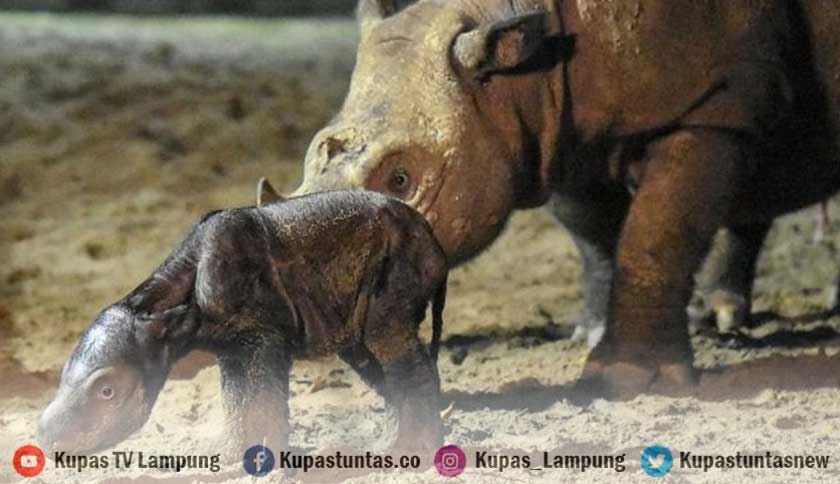Female Sumatran Rhino Calf Born in Way Kambas National Park Lampung

Ratu with her newborn baby rhino that was born in the Sumatran Rhino Reserve (SRS) Way Kambas National Park (TNWK), East Lampung, Saturday (30/9/2023). Photo: TNWK
Kupastuntas.co, East Lampung - A female
Sumatran Rhino calf (Dicerorhinus Sumatrensis) was born in the Sumatran Rhino
Reserve (SRS) Way Kambas National Park (TNWK), East Lampung, Saturday (30/9/2023).
The rhino calf was born to the rhino pair Ratu
and Andalas. Currently the rhino calf is still under the supervision of a team
of doctors. SRS TNWK management is also still sterilizing the cage where the
baby rhino is born.
Public Relations of the TNWK Center,
Sukatmoko, said that his party and the medical team are still monitoring
newborn rhino calves via closed circuit television (CCTV).
"The cage where the baby rhino is born is
still being sterilized, not everyone is allowed to enter the rhino breeding
location. Only doctors who handle the birth of baby rhinos can enter,"
said Sukatmoko, Sunday (1/10/2023).
Sukatmoko revealed that the mother rhino,
Ratu, who is now 23 years old, has given birth to three rhino calves while
living at SRS TNWK.
"So the Queen Rhinoceros has given birth
to three rhinoceros calves. Currently in SRS there are 9 Sumatran rhinos
consisting of 3 males and 6 females," he explained.
Sukatmoko explained that monitoring of
children's bodies is carried out 24 hours. "Monitoring of the Ratu rhino
and its calf was carried out via CCTV for 24 hours until they were declared to
be in a healthy condition. Until now, the mother and calf are still in good
health," he said.
For your information, the first rhino calf
born to the Badak Ratu mother in 2012 was named Andatu.
Then, the second rhino calf was born in 2016,
female, named Delillah. Finally, the child of the Badak Ratu was born again as
a female and has not yet been given a name.
Previously, the Minister of Environment and
Forestry (KLHK), Siti Nurbaya also appreciated the birth of a baby Sumatran
Rhino at TNWK.
“This news is certainly happy news, not only
for the Indonesian people but also the world. I give my highest appreciation to
the parties involved in the birth of the Sumatran Rhino. "Hopefully, we
can continue to receive happy news from the births of Sumatran rhinos and other
protected animals in the future," said Siti Nurbaya in a written
statement, on Saturday (30/9/2023).
Siti said that the birth of this rhino calf
proves the government's commitment to carrying out rhino conservation efforts
in Indonesia, especially the Sumatran Rhino. With the birth of a rhinoceros
calf from the Rhino Queen's mother, this increases the number of rhinos in the
SRS TNWK to nine.
Apart from the Ratu rhino, the other rhinos
currently occupying the SRS TNWK are Bina, Rosa, Delilah and Sedah Mirah. And
there are three male rhinos, namely Andalas, Harapan, and Andatu.
"From the semi-natural breeding efforts
currently being carried out, SRS TNWK has succeeded in producing four Sumatran
rhino calves, namely Andatu (2012), Delilah (2016), Sedah Mirah (2022), and the
third child from Ratu-Andalas (2023). he explained.
Director General of Natural Resources and
Ecosystem Conservation (KSDAE) KLHK, Satyawan Pudyatmoko added, SRS TNWK in Way
Kambas National Park is the only semi-insitu breeding site managed by the Way
Kambas National Park Center in collaboration with the Indonesian Rhino
Foundation (YABI).
"The main goal is to produce Sumatran
rhino calves to maintain the survival of the Sumatran rhino species which is
now threatened with extinction. Sumatran rhino calves resulting from the
breeding program at SRS TNWK can in future be released back into their natural
habitat," he said.
Executive Director of the Indonesian Rhino
Foundation (YABI), Jansen Manansang said that not only through natural
reproduction efforts, technological assistance is also needed to optimize the
breeding of Sumatran Rhinos.
"SRS TNWK plans to integrate the Assisted
Reproductive Technology (ART) method for breeding Sumatran rhinos," said
Jansen.
"The breeding in Way Kambas is an effort
to maintain the rhino population, especially the Sumatran species. Because the
rhino population is decreasing in the wild," he said.
He continued, in the future the rhinos
produced from the breeding program at SRS TNWK will still be released into the
wild so that the rhino population continues to be maintained and to prevent
inbreeding.
Based on Minister of Environment and Forestry
Regulation No. 106 of 2018 states that the Sumatran rhino (Dicerorhinus
Sumatrensis) is a protected animal in Indonesia.
The existence of the Sumatran rhino is spread
across forests on Sumatra Island such as Gunung Leuser National Park, Way
Kambas National Park, and Bukit Barisan Selatan National Park as well as a
small part in East Kalimantan. (*)
Berita Lainnya
-
Crude Oil-Like Waste Pollutes Bandar Lampung Beach, Fishermen Have Difficulty Finding Fish
Senin, 13 November 2023 -
271 Hectares of Agricultural Land in West Lampung are at Risk of Harvest Failure
Rabu, 25 Oktober 2023 -
11 Coal Stockpiles in Bandar Lampung Operate Near Residential Settlements
Rabu, 25 Oktober 2023 -
30,631 Recipient Families in West Lampung Receive Phase Two of Rice Social Assistance
Selasa, 24 Oktober 2023









